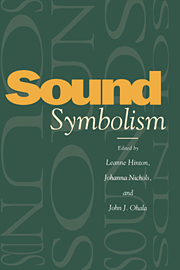Book contents
- Frontmatter
- Contents
- List of contributors
- 1 Introduction: Sound-symbolic processes
- PART I Native American languages north of Mexico
- PART II Native languages of Latin America
- PART III Asia
- PART IV Australia and Africa
- PART V Europe
- 14 Regular sound development, phonosymbolic orchestration, disambiguation of homonyms
- 15 Modern Greek ts: beyond sound symbolism
- 16 On levels of analysis of sound symbolism in poetry, with an application to Russian poetry
- 17 Finnish and Gilyak sound symbolism – the interplay between system and history
- PART VI English
- PART VII The biological bases of sound symbolism
- Index
16 - On levels of analysis of sound symbolism in poetry, with an application to Russian poetry
Published online by Cambridge University Press: 04 August 2010
- Frontmatter
- Contents
- List of contributors
- 1 Introduction: Sound-symbolic processes
- PART I Native American languages north of Mexico
- PART II Native languages of Latin America
- PART III Asia
- PART IV Australia and Africa
- PART V Europe
- 14 Regular sound development, phonosymbolic orchestration, disambiguation of homonyms
- 15 Modern Greek ts: beyond sound symbolism
- 16 On levels of analysis of sound symbolism in poetry, with an application to Russian poetry
- 17 Finnish and Gilyak sound symbolism – the interplay between system and history
- PART VI English
- PART VII The biological bases of sound symbolism
- Index
Summary
Introduction
With respect to sound symbolism, I accept as a premise the position which appears to me self-evident, and in any case proved in psycholinguistic experiments: that both synesthetic (or: universal) sound symbolism and conventional (or: local) sound symbolism coexist in every language. I suggest that this coexistence is precisely what should be suspected: it is surely natural that the direct links between sound and meaning should be based both on phonetics and on the lexicon.
This is very probably a simplification of the real state of affairs. I suggest, however, that it is worth following this simplified hypothesis to its conclusion: namely, that it is to be expected that different languages will have synesthetic and universal sound symbolism in differing amounts. Over time, the sound changes and the semantic changes that occur may bring the two closer together, or, conversely, may force them further apart, and hence some languages may be expected to have richer overall sound-symbolic associations than others: thus, reputedly, Korean, and some West African languages.
I think that there are more factors at work than this stark dichotomy suggests; in particular, it seems that there are cultural factors that may or may not emphasize the use of certain kinds of sound symbolism for certain purposes. Nevertheless, I suggest that the disparities between the scope of sound symbolism in different languages may be explained at least in part by the “coalition-or-conflict” theory I have outlined.
- Type
- Chapter
- Information
- Sound Symbolism , pp. 237 - 248Publisher: Cambridge University PressPrint publication year: 1995
- 3
- Cited by



